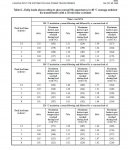mbrooke
Batteries Included
- Location
- United States
- Occupation
- Technician
It seems a cable could overcome 31.8% overload in cable duct for 4 hrs.-for instance- but transformer only 5%.
See IEEE 5796/1993 Table 6 compare with IEEE 242/2001 9.5.2 Overload capacity[for cable].
I thought if one intends to replace the actual transformer with another larger and keep the secondary cable.
Can you copy and paste the table?

